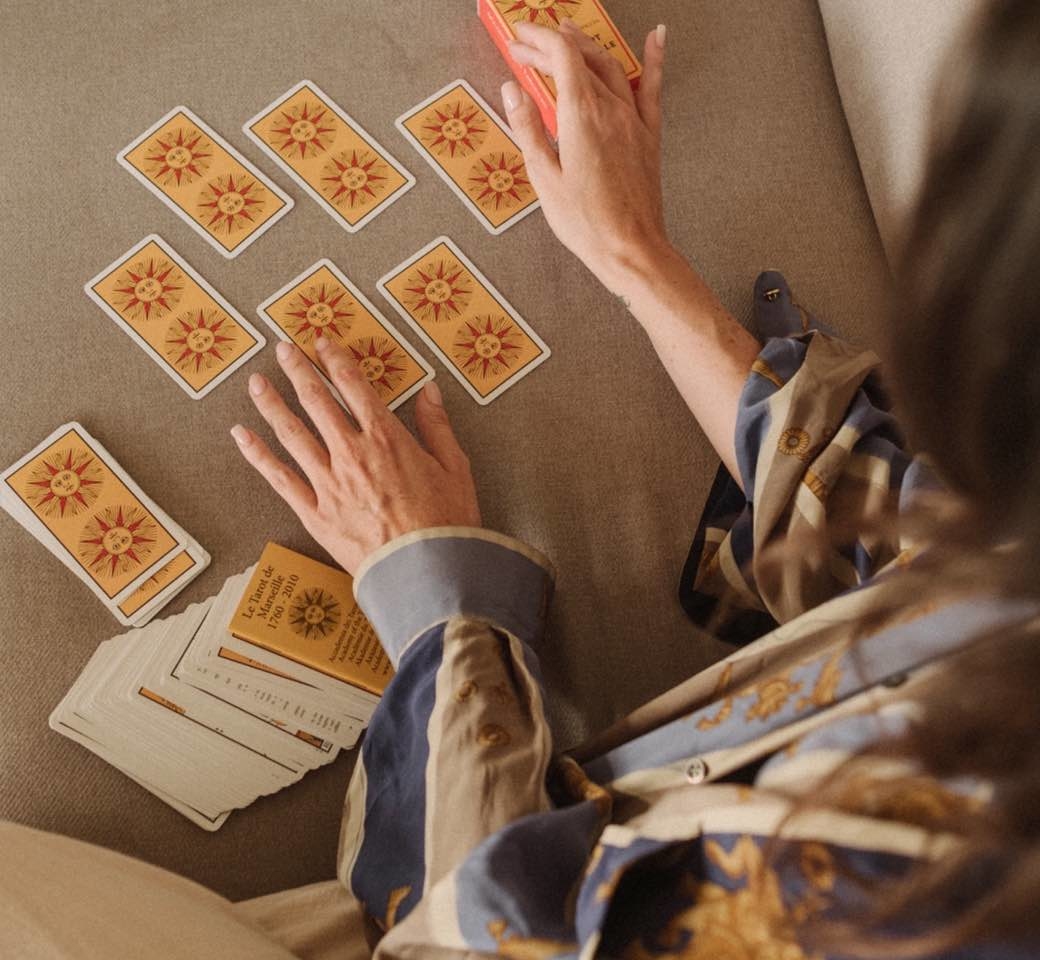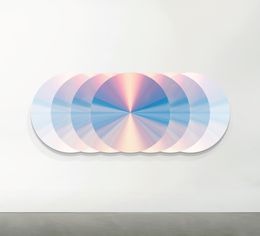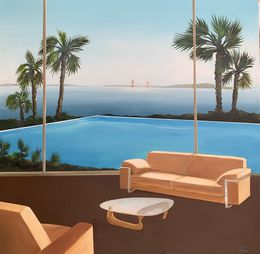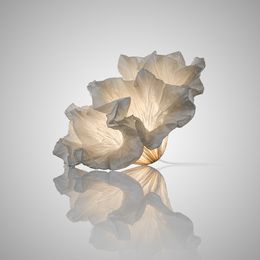
Meet Irène Olczak
Feminist entrepreneur and founder of Paulette Magazine

Portrait of Irene at home © Louise Skadhauge
Irène Olczak is an entrepreneur who's always up for new challenges. In 2009, at only 23 years old, she founded Paulette Magazine, which quickly revolutionized the women's press. Irène has built her empire without ever losing sight of her main objective: to celebrate the uniqueness of each individual. The Artsper team met with this incredible woman who lives in between Marseille and Paris to share her inspiring journey, in which art plays a major role.
1. Hello Irene! Can you tell us about yourself and your professional journey?
My name is Irène Olczak, I am 37 years old, and I grew up in the Paris area. I come from a double culture: my mother is Turkish, and my father is of Polish origin. I have dual French-Turkish nationality. I studied graphic design and art direction at a school of applied arts, called Olivier de Serres. I then did a short stint in an advertising agency where I worked as a creative director. In 2009, at the age of 23, I decided to launch my first company, called Paulette Magazine. It's a feminist and women's magazine, promoting open-mindedness. The project promotes inclusiveness, diversity and representation. In 2018, 9 years later, I co-created my second company, called ESO Paris. This project is all about spirituality and astrology. We do various events, collaborations with artists, courses with the ESO School, and talks to raise awareness on the subject. In 2020, I co-created my third company, called 11H11 Holistic Project. The Covid crisis impacted us, but the project still lives today through events, and thanks to our partnership with Soho House! We teach classes to reconnect the body and mind through energy and wellness practices such as breathwork, meditation, yoga, Reiki, sophrology, sound bathing, intuitive dance... We surround ourselves with practitioners to express ourselves at different events. Well, that sets the scene!
2. You live between Marseille and Paris, two cities with rich but very different - sometimes opposing - cultures. How do you find your balance between these two environments? How do they inspire you?
Paris is synonymous with beauty, creativity, romance... There is something poetic in this city, which is also extremely intense. I used to work a lot while living in Paris, with a very sustained rhythm. I was in "automatic pilot" mode, in a tunnel... pretty much as if I was 24/7 in the subway! One would walk, would zigzag, but would never necessarily pay attention to what's going on around them. The only thing that matters for Parisians is to manage their professional life, their social life, and their ambitions all at the same time... The cost of living there is extremely high, and the city's atmosphere requires people to be very strong.
On the other hand, Marseille, despite its equally powerful energy, evokes a kind of tranquility, of gentleness. The city has a lot of character, because of its proximity to the elements of nature. I love its sea that enters the city, its creeks, its greenery and its beautiful corniche where you can observe the Mediterranean Sea as far as the eye can see... This city inspires me because I find it very feminine, I envision it as a strong woman. Marseille, for me, is a woman who knows her worth, who is very confident but at the same time kind and simple. What I like about this city is that one can't hide, and it allows one to live in the moment and to be well anchored in reality. Above all, the relationship to work is different, the work days end earlier. It's easier to reconnect with the simplest pleasures in life in Marseille. I'm not saying that it's impossible in Paris, it would be very binary to say that, but I find that it is all the more visible in Marseille. I feel like I'm always in a rush when I'm in Paris.
It's a chance to be able to live between these two cities since it offers me an interesting balance. Paris offers me its opportunities, its gastronomy, its cultural events... Even if Marseille is ultra dynamic, whether in culture, food or fashion! The local young generation is impulsing new things and I think Marseille will slowly but surely become more important in the years to come. Anyway, both cities inspire me in their own way, but it's clear that neither of them is easy. They are cities of character, and I like that because they challenge me.


On the left: Portrait of Irene © Louise Skadhauge / On the right: Some copies of Paulette Magazine © Irene Olczak
3. You are the founder and editor-in-chief of Paulette Magazine, which has revolutionized the women's press. Where did your intuition come from to launch this project in 2009? What did your moodboards look like?
As for many entrepreneurs, the intuition came from a very personal observation: Society has built the image of a stereotypical woman that is completely erroneous, sometimes even unreal. In 2009, the Internet was not as popular as it is today, Facebook had been around for two years, so we were not yet completely - even not at all - under the influence of social platforms. The people who were active online in France were still early adopters. As for me, I was quite a digital native, so I was quickly very active on various platforms. I saw the new wave of freedom and diversity they could bring, especially the diversity of voices, which could now be heard on a large scale. Although women were still reading a lot of women's press at the time, it was still impossible to find diversity in magazines. People from minorities, non-white people, people with disabilities, people who didn't fit into traditional beauty standards, were not represented. This message began to resound: "We want to be represented too, it's not normal that we don't exist in the public visual space and advertising!" I think that many women saw that. Thank god for the internet, and for what it brought in terms of representation... Paulette was all about inclusivity, but with the will to express it in the print press. The magazine is a very statutory object that leaves a trace in its time and which is complementary to the magic digital can bring. That's why we built the brand under the cross-platform model.
The moodboards looked like what we've been doing for the last 13 years! (laughs). There were different profiles of people that we could call "Misses All", color, creativity, originality... Magazines are also meant to make us travel and dream! We wanted to show things that everyone could relate to. It was a mix of street style photos, which was just starting to emerge on blogs, and more cinematic photos. From the beginning, the magazine was shot 95% on film. The goal was to show softness and kindness. It was very important for us to convey these ideas in a creative and poetic way.
4. You studied at the Olivier de Serre School of Applied Art and worked in an agency as a creative director. Which artists inspire you?
I am a very spiritual person, I think it was passed on to me by my roots. I come from a dual Christian-Muslim culture, my parents were atheists, but spirituality has always been very present in my life. I am very happy to explore it further with my ESO project. What I love about art, especially painting, is the way artists slip subliminal messages into their work. I love it when a painting leaves room for a multitude of interpretations, as is the case in many art movements. My favorite is Surrealism, for its poetry. I could look for hours at the works of artists like Dalí, Miró, Magritte, Picasso, or Frida Kahlo, whom I admire... Contemporary art speaks to me the most. I haven't read much in my life, I don't have that literary background, so I'm more sensitive to emotion, to symbolism, and to colors. In this sense, Rothko's work moves me a lot. On another note, the architecture that can be found in Hockney's works appeals to me enormously; it is what I call "beauty that feels good". And Jean Cocteau's linework, too!
5. You usually share your artistic finds on your Instagram account. Can you tell us about one of your recent discoveries?
I've discovered three artists recently. The first one is Jenny Morgan, whose work has a bit of a mystical side. She represents faces, monochromes, symbols... I find her style very powerful. Then there is the work of Brazilian artist Samuel de Saboia. His works are full of colors, very dynamic, less zen than those of Jenny Morgan but with a strong message. Finally, the work of Moonassi or Kim Daehyun, who is a Korean artist. He works in black and white, with standardized characters, which he associates with installations. His art makes me think of the concepts of consciousness and subconsciousness.


Details at Irene's home © Louise Skadhauge
6. You love starting new businesses, you're curious, and you have a fast-paced life... How do you manage to reconcile your passions and your projects?
I try to turn my passions into projects! Everything I do is based on something I am passionate about. I manage to include my interests in everything I do. If I like ceramics or painting, I'll find a way to do an exhibition or workshop with Paulette. I'm experimenting with esotericism with ESO, with wellness with 11H11... The key is to combine passions and projects. And above all, I rely on teams and partners who allow me to multiply these initiatives. I don't do it alone! We often have the impression that people move forward without anyone's help, but it is thanks to collective work that all these ideas come to life!
7. What place do you give to art in your daily life? Are you an art collector? Do you pay particular attention to the decoration of the place in which you work or live?
Since 2020, I've been transitioning to a new lifestyle. I went through a life cycle where I gave everything for my work, I sacrificed a lot. I didn't necessarily allow myself to do a lot of things; the priority was to get all the work done, to reach the goals. I think I neglected myself. For the past 2 years, I have felt the need to apply the same level of requirements to my living environment. I was already paying attention to it before, but I was spending my money differently. For 10 years, I was in contact with artists who were just starting out and who are now famous, including Inès Longevial, and many others, whom Paulette featured at their beginnings. Even if I had had the money at the time, I would not have had the reflex to buy their works, even if they were pretty affordable. I didn't see any interest in it because I was only thinking about productivity, and I didn't really pay attention to where I lived.
Today, I feel like I am in the second stage of my life. I am discovering maturity, and I pay more attention to beauty. I am very sensitive to energy, I need a lot of light and I surround myself with things that can send me a soothing message whenever I need it. I like everything that evokes consciousness, that's why I have a lot of stones at home. The works I have at home are spiritual and allow me to step back. I decorate my walls with images, some of them by Inès Longevial, and I bought a large silk-screen print by a young artist from Marseille when I moved there... It's a beautiful and fun work showing a volcano exploding in front of the sea. At the top of the piece, you can read the caption: "In the meantime...". It reminds me that we must always keep things in perspective. I have had a tendency to accumulate things, and these days I want a more minimal interior to relieve me of all that energy. I have been working on these issues since I moved to Marseille, because in Paris I was on "automatic pilot mode". During these two years, I became aware that our environment shapes our being. I want to do good to myself and to others, which is why I am in a process of liberation, unlike before when I tended to accumulate objects.
8. Paulette and Artsper have collaborated in the past, and other projects are underway... What do you think our two brands and teams have in common?
I think we want to surprise people. We share the objective of desacralizing art to make it accessible. Art is above all creation. It is the expression of an emotion, of a moment... It is something universal. One can have no knowledge on the subject and appreciate art, whatever the social environment from which one comes. We can all be moved and cry in front of a painting if it awakens a wound, a trauma, a joy... Artsper and Paulette have the will to awaken, to gather, to democratize. I also find that there is a lot of benevolence and joy in our two brands, and in what we want to bring to the world.
9. Finally, what is the most beautiful museum you have visited?
When traveling, visiting museums is my second favorite activity after discovering the local gastronomy! I love to observe the architecture of museums, and the Louvre is a must for me. There is something quite mystical in its pyramid, its courtyard, its underground part, its skylights... I also love the Palais de Tokyo, I come there mostly to experience emotions. The Louvre in Abu Dhabi and the Guggenheim in Bilbao also look like a lot of fun!
Their favorite artworks

















